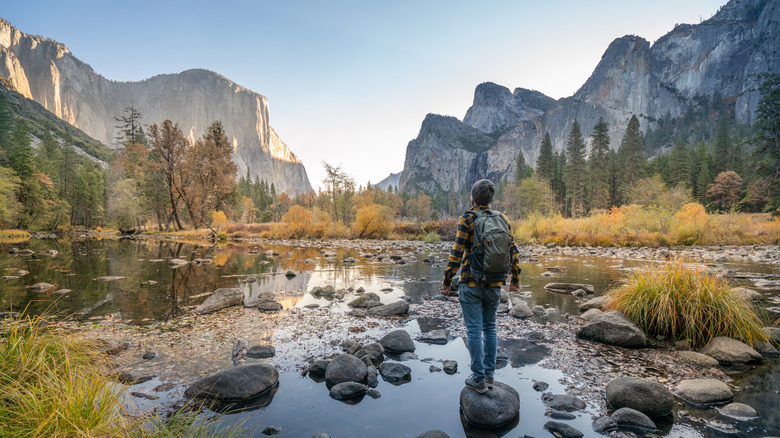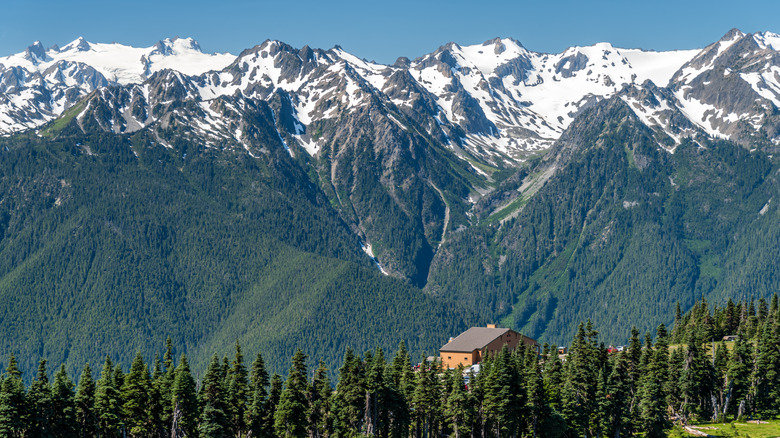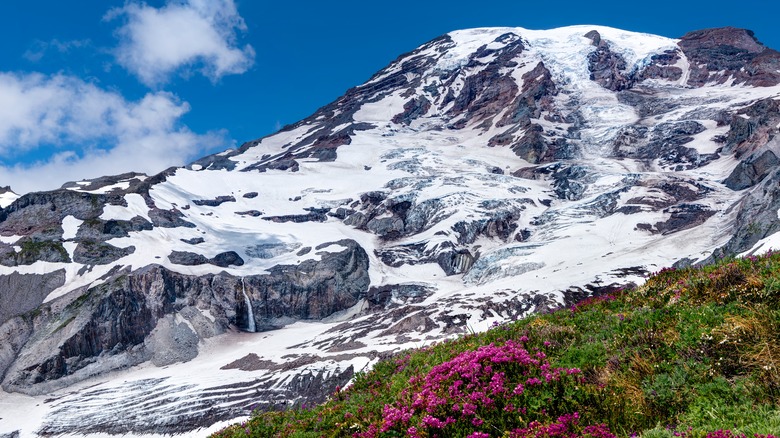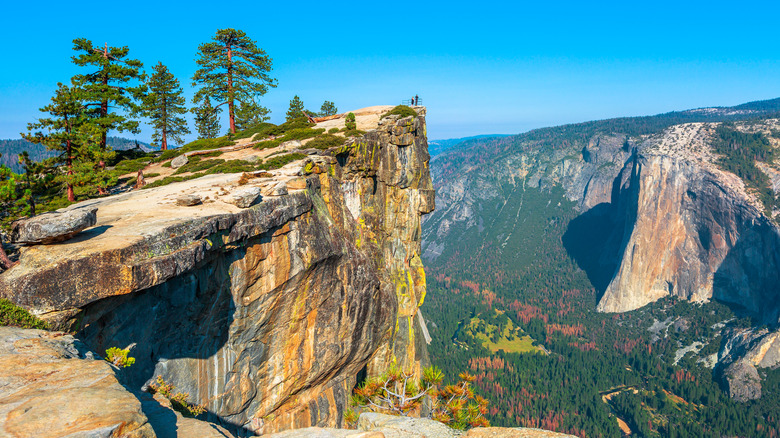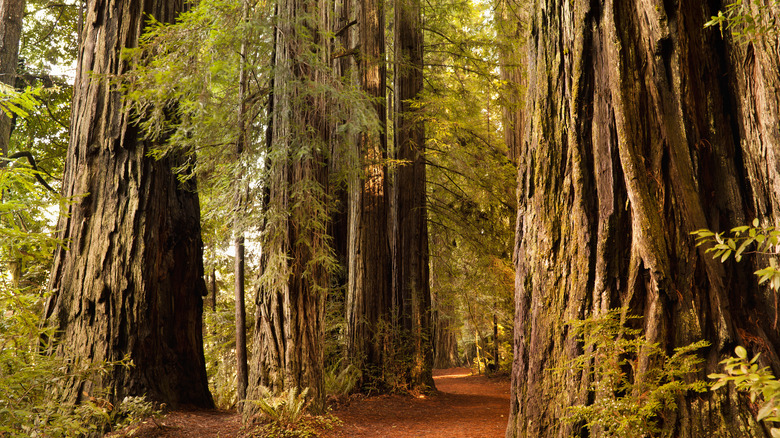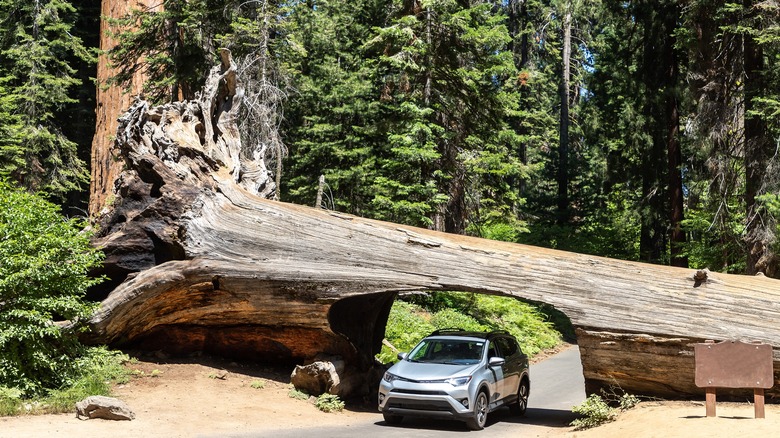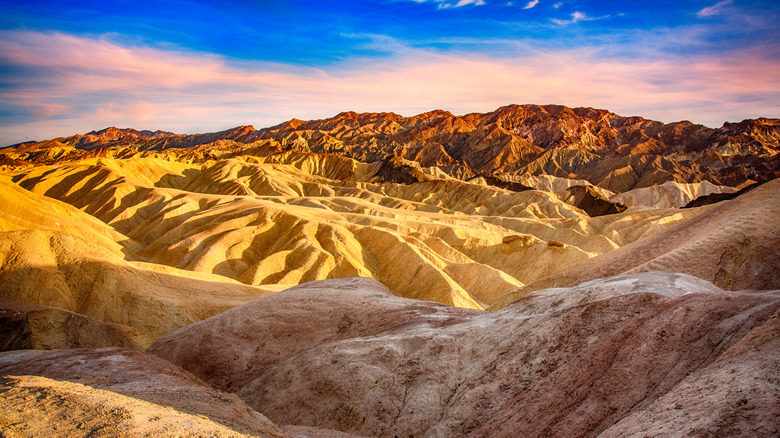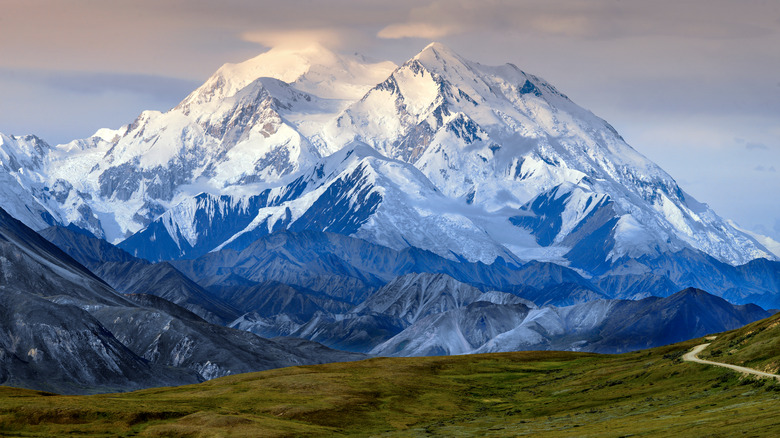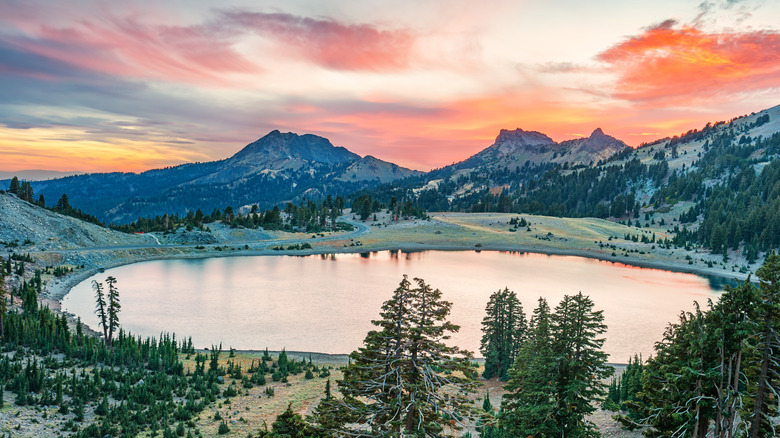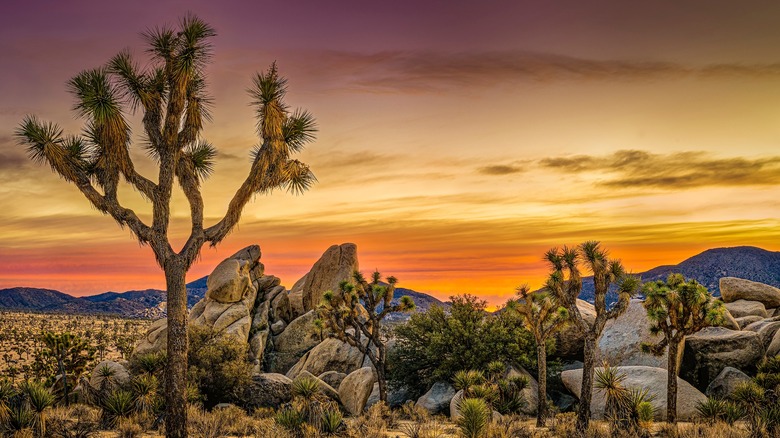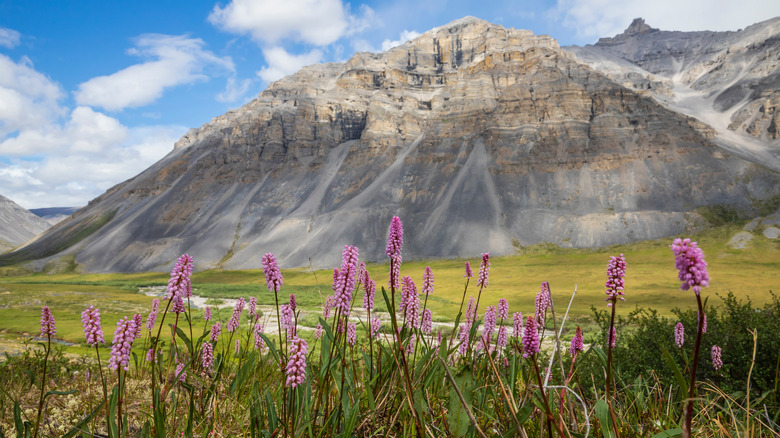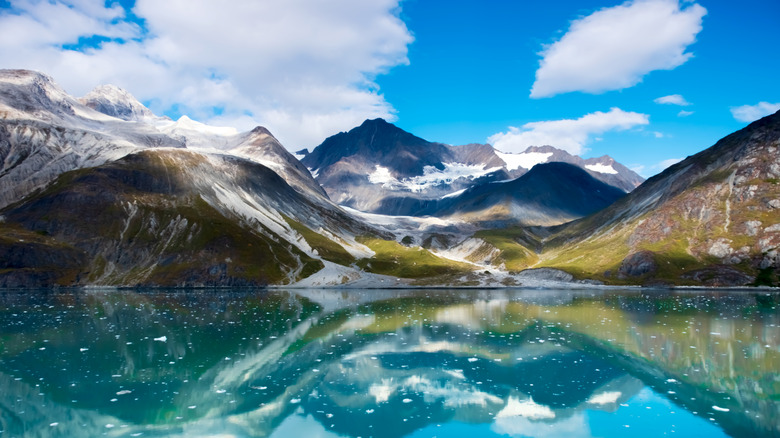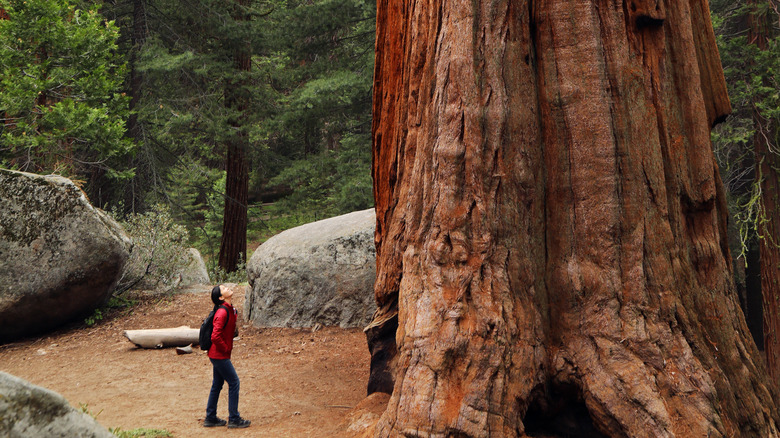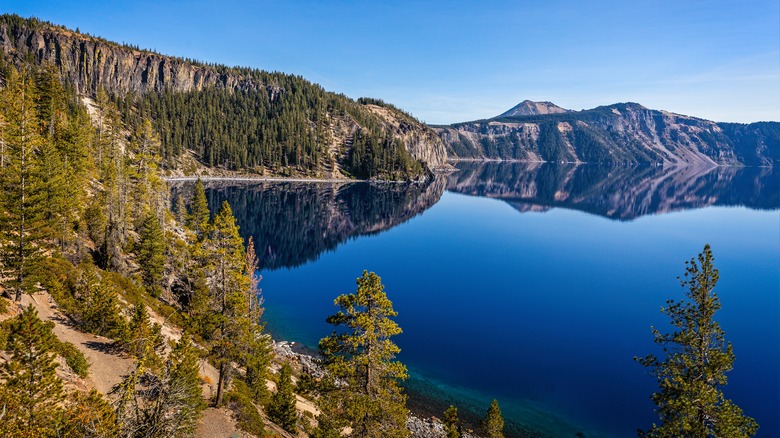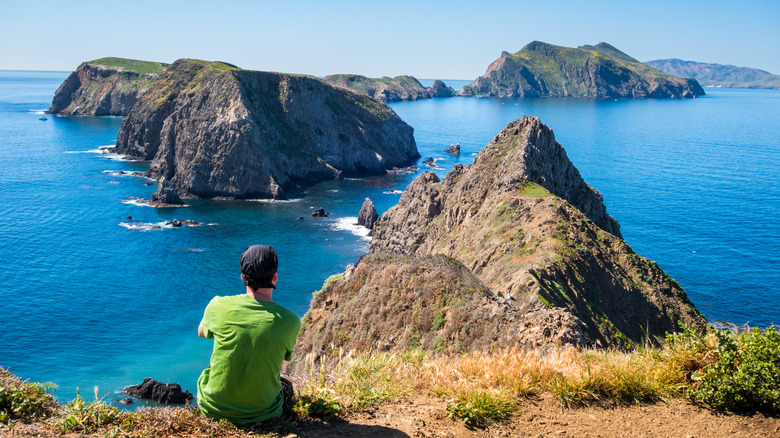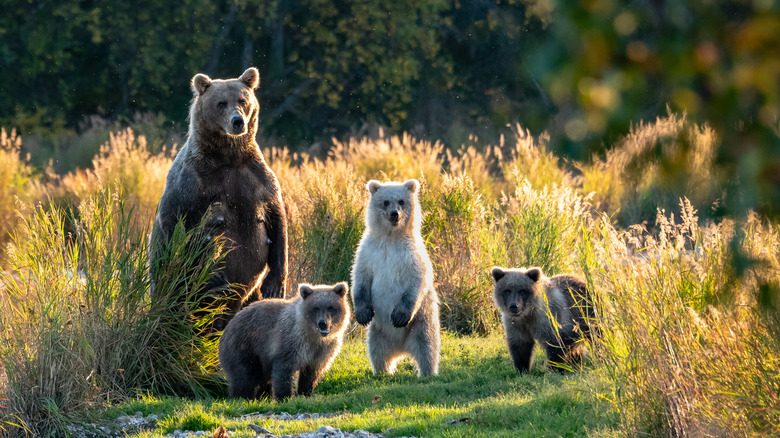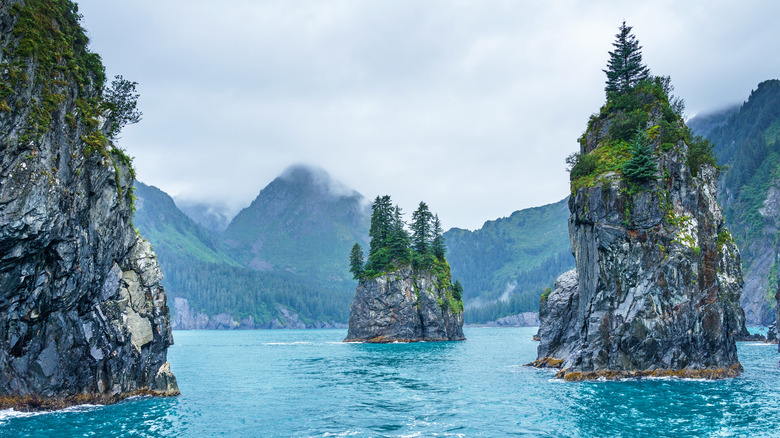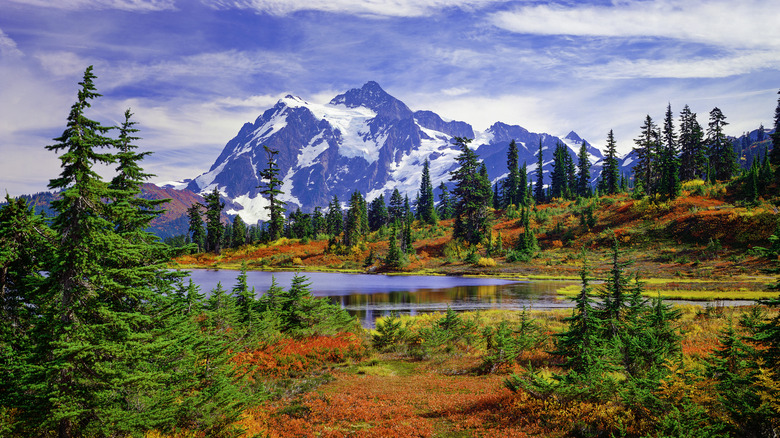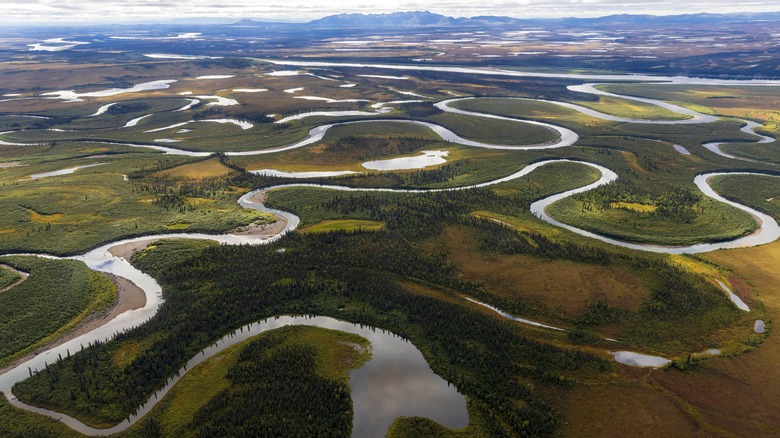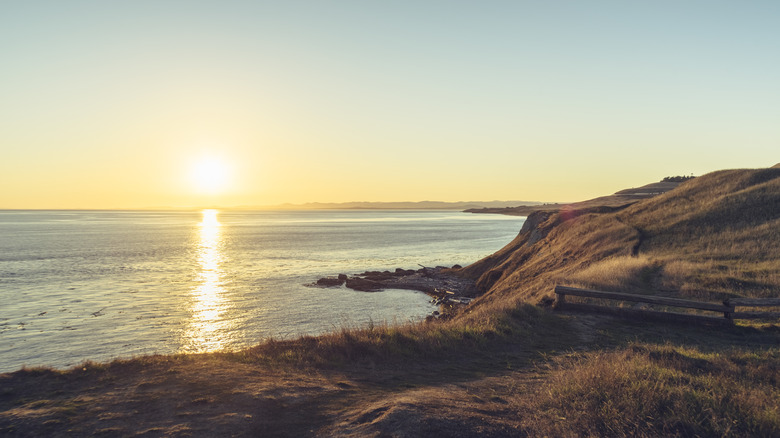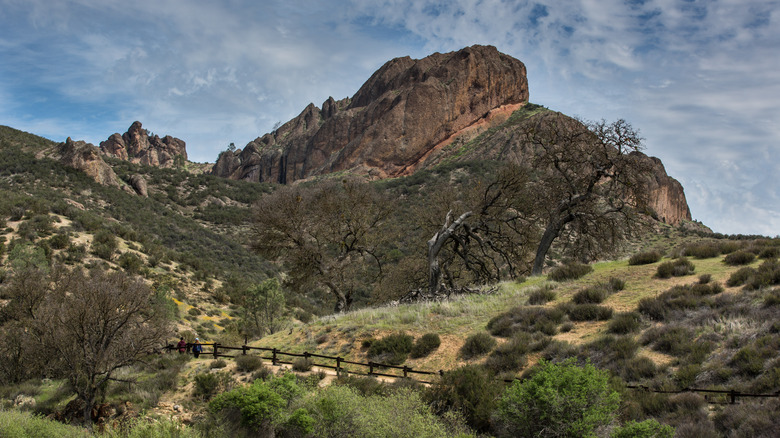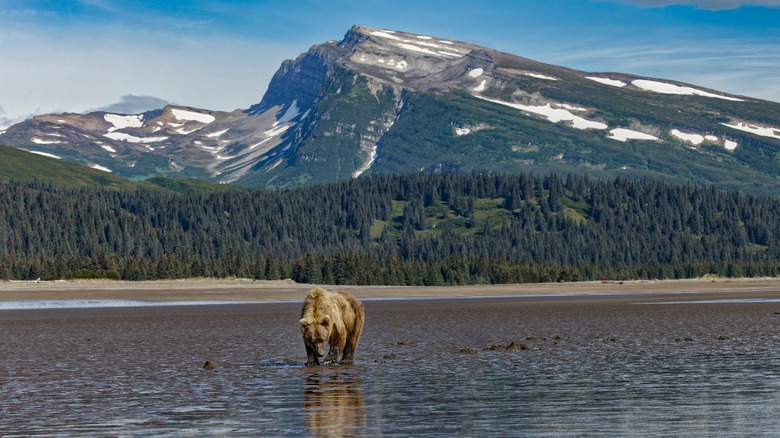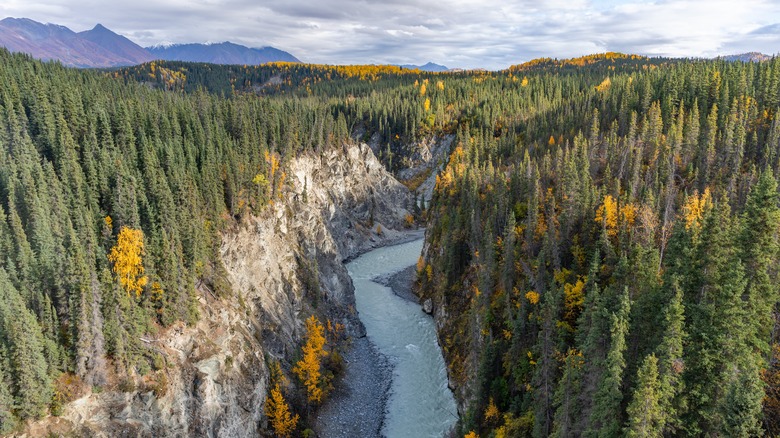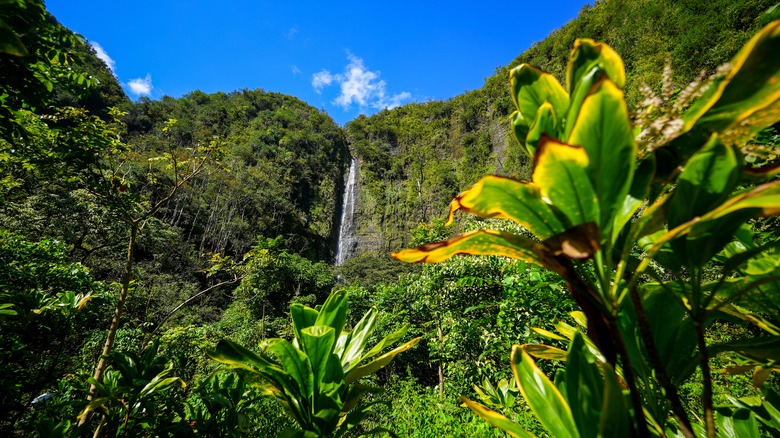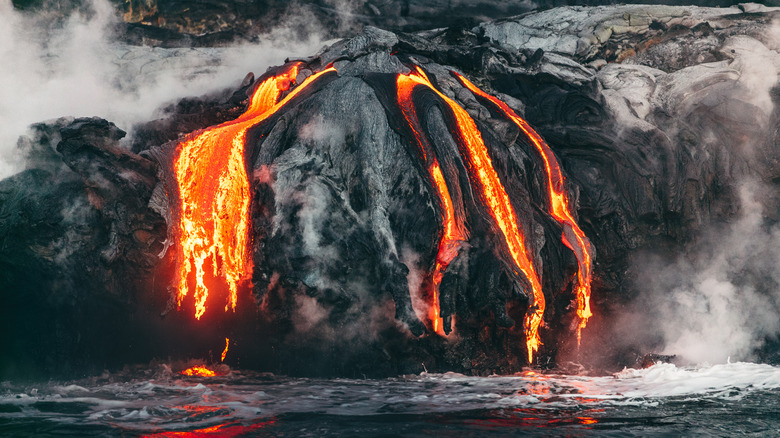24 Must-Visit National Parks To Add To Your West Coast Bucket List
The first national park — Yellowstone, located mainly in Wyoming — was established in 1872. Today, there are 63 national parks from coast to coast. Some of the most beautiful among them, including Yellowstone, are located in the West Coast states of Washington, Alaska, Oregon, California, and Hawaii. From the snow-capped mountains of Olympic National Park in Washington State to the giant redwood trees in Redwood National Park in California, there's a lot of beauty to behold. Whether you only have time to see one, or you plan to see them all, here are the best ones to bookmark for your adventure.
Olympic National Park
You'll get a little bit of everything when you visit Olympic National Park. Sprawling across 1 million acres, it's one of the most diverse national parks with three distinct ecosystems, including snow-capped mountain peaks, temperate rain forest, and miles of jagged Pacific coastline. Such diversity results in marked differences in elevation, temperature, and precipitation. Consistently rated one of the best national parks, it offers loads of spectacular beauty and tons of activities including hiking, biking, kayaking and canoeing, camping, and whale watching.
The best time to visit Olympic National Park is during the summer. That's the dry season in the Pacific Northwest and prime wildflower time, and you're most likely to have warm temperatures and blue skies. However, keep in mind that this is also the high season, so you will have to share the beauty with a portion of the over 3 million visitors that flock to the park each year.
Mount Rainier National Park
The fifth national park established in 1899, Mount Rainier is a short drive from Seattle and perfect for a day trip or overnight if you're staying in the city. Like Olympic National Park, Mount Rainier is celebrated for its dramatic glacier-capped peak, starkly contrasted with meadows full of wildflowers in the summer months. In fact, Rainier's peak has the most glacier coverage of any in the lower 48 states. And what many people don't know is that Mount Rainier is an active volcano. Although it's been dormant for 1,000 years, it is expected to erupt again in the future.
The most adventurous visitors attempt to climb the peak, which reaches nearly 3 miles into the sky, but only about 50 percent successfully summit it. For the more leisurely visitor, the park offers hundreds of hiking trails, including the Wonderland Trail that wraps all the way around the mountain. You can also camp, snowshoe, backcountry ski, and view more than 280 species of wildlife, including Stellar jays, marmots, and black-tailed deer.
Yosemite National Park
Nestled in the High Sierra of California, Yosemite, the oldest national park, stuns with its deep valleys, towering granite cliffs, snow-capped glaciers, and vast lakes. Yosemite is best known for its numerous gushing waterfalls, including Yosemite Falls, which is one of the tallest in the world at 2,425 feet.
The best time to see Yosemite Falls is in the springtime, and they can be viewed from the road and from hiking trails, including a strenuous full-day hike to the top. In addition to hiking, visitors can camp, bike, bird watch, ride horses, raft the Merced River, ski and snowshoe, and fish. Yosemite is especially well-known as a destination for some of the world's best rock climbing, including the famed El Capitan rock formation.
Redwood National Park
Redwood National Park is named for the giant trees that inhabit its 172 square miles — some of the largest and oldest in the world. In fact, one of these mammoths takes top rank as the world's tallest tree at 381 feet — equivalent to the height of a 35-story building and taller than the Statue of Liberty.
Living among the trees are black bears, bobcats, Roosevelt elks, coyotes, and black-tailed deer. The park also has 40 miles of wild coastline, sprawling prairies, rushing rivers, lagoons, and marshland. Popular activities include hiking, whale watching, fishing, canoeing, and swimming.
Sequoia National Park
About five hours southeast of Redwood is Sequoia National Park, which is home to the world's largest living entities — the giant sequoia trees. One of these naturally ranks as the largest tree, by volume, in the world. The base of the General Sherman Tree is an astounding 36 feet in diameter — about the same width as a tennis court or the length of a yellow school bus. It's enough to just wander for hours or days between these rust-colored behemoths along the 800 miles of hiking trails. If you need more, spelunking, horseback riding, fly fishing, cross-country skiing, and snowshoeing are other ways to enjoy the natural splendor of the park.
Death Valley National Park
Death Valley is often said to be the hottest place on Earth with a high temperature of 134 degrees Fahrenheit recorded in 1913. That's not how it got its name though. In the winter of 1849-1850, a group of explorers lost their way in the valley. All feared for their lives, and one came to an untimely death. Upon exiting the valley, one of the group is reported to have said, "Goodbye, Death Valley." And so it was called.
Such an ominously named and blistering hot location doesn't seem like it would be a popular destination, but almost 1 million visitors come every year to see the stunning landscape of sand dunes, snow-capped mountains, wildflower meadows, and deep canyons spread across the park's 3,422,024 acres. Huge is an understatement — it's the largest of all the national parks in the continental U.S. Almost 1,000 miles of paved and dirt roads lead visitors to access points for hiking, camping, mountain biking, backpacking, trail running, and more. There's even a self-guided Star Wars driving tour.
Denali National Park
One of the largest national parks, Denali National Park encompasses a little over 6 million acres, 1 million of which are covered by glaciers. At 20,000 feet, Denali is the highest peak in North America. This spot draws mountaineers from all over to attempt to summit the mammoth. Other draws to the park include a chance to view the Aurora Borealis from fall through early spring as well as the large wildlife species that call the park home, including Dall sheep, wolves, grizzly bears, and moose.
Lassen Volcanic National Park
As its name gives away, Lassen Volcanic National Park in California is home to several volcanoes. In fact, you can find all four varieties of volcanoes that exist in the world — shield, plug dome, Cinder Cone, and Composite. Visitors will also come across hydrothermal activity in bubbling, steaming hot water pools, boiling mud pots, and fumaroles releasing volcanic vapors and gasses. You can see these features by car or hiking through the park's more than 150 miles of trails. In winter — which often lasts until July — backcountry skiing and snowshoeing are popular activities.
Joshua Tree National Park
Named for the iconic otherworldly Joshua tree (which is actually a cactus) that dots the desert landscape, Joshua Tree Park in California comprises an area of nearly 800,000 acres. Only 15% of that can be seen by visitors — the other 85% is managed wilderness. But there's so much to see and do in that 15% you won't miss out on anything.
For wildlife lovers, there are 57 species of mammals in the park, including big horn sheep, jackrabbits, coyotes, mountain lions, and bobcats. If stargazing is your thing, Joshua Tree National Park was named an International Dark Sky Park for its low levels of light pollution and is one of the best areas in Southern California for viewing the night sky.
Gates of the Arctic National Park
Gates of the Arctic National Park is the second largest, covering an astounding 13,238 square miles north of the Arctic Circle. It's also one of the least-visited national parks in the United States, which makes sense since there are no roads or dedicated trails that lead there. Access is either via plane or backcountry hiking. In addition to hiking and backpacking, visitors come to fish and raft the many floatable rivers. In winter, cross-country skiing and dog mushing are popular activities. There are also plenty of opportunities to spot the grizzlies, Dall sheep, moose, wolves, and wolverines protected by the park. One of the largest herds of Caribou in Alaska, with around 200,000 members, also calls the park home.
Glacier Bay National Park
The fact that it's been designated a UNESCO World Heritage Site tells you just a little bit about the splendor of Glacier Bay National Park. Its 3.3 million acres form a diverse biosphere of glacier-capped mountains, rainforests, rugged coastlines, and cavernous fjords.
The majority of Glacier Bay is water, so exploration by boat, whether on a kayak or a cruise ship, is one of the best ways to see it. Hiking, mountaineering, backpacking, and rafting are other options for the adventurous visitor. Most of the park is wilderness, but Bartlett Cove offers a visitors center, dedicated trails, and a campground for those looking to be a little more connected to civilization.
Kings Canyon National Park
Just adjacent to Sequoia National Park and its world's largest tree, King's Canyon National Park has the world's second-largest tree — the General Grant Tree. The park also features Redwood Grove, which is the largest Sequoia grove still in existence. The other main attraction here is the canyon for which the park is named. Kings Canyon is the deepest in North America at a maximum depth of 8,200 — deeper than even the Grand Canyon which maxes out at 6,000 feet.
Crater Lake National Park
Crater Lake was formed almost 8 millennia ago when a giant peak came crashing down, forming a deep gorge that resulted in the deepest lake in North America. Sitting high in the Cascade Mountain range, its waters are sparkling blue and pure, fed only by precipitation.
More than 90 miles of hiking trails afford stunning vistas of the lake and the mountains surrounding it. However, with an elevation of 7,000 to 8,000 feet, the area gets considerable snowfall, and trails are often snow-covered until June. Summer is the high season, and the scenic Crater Lake Rim Drive fully opens in July.
Channel Islands National Park
Often referred to as the "Galapagos of North America," Channel Islands National Park is a chain of five islands off the coast of southern California. Like the Galapagos, the Channel Islands are surrounded by a diverse marine environment in which thrive hundreds of animal and plant species, including dolphins, sea lions, seals, sea otters, spiny lobsters, whales, sunflower stars, and giant black seabass. On land, visitors can spot several bird, mammal, and plant species endemic to the islands, including the spotted skunk, island fox, island scrub jay, Island paintbrush and Torrey pine.
Katmai National Park
In Alaska's Katmai National Park, bears are the main attraction. Brooks Camp on Naknek Lake is a thriving bear-viewing center only accessible by boat or float plane. Bear-viewing platforms give visitors prime views of great brown bears catching salmon at the waterfall's edge in the summer and fall.
During Fat Bear Week in early October, the bears are most active, filling up on fresh fish before they go into hibernation for the winter. Other park attractions include the Valley of 10,000 Smokes, a desolate but stunning landscape formed by the biggest volcanic eruption of the 20th century. In 1920, the Novarupta volcano spewed ash as high as 20 miles into the sky for a period of 60 hours, turning the Ukak River Valley into a 40-square-mile ashen desert.
Kenai Fjords National Park
Kenai Fjords National Park in southcentral Alaska is a 607,805-acre wonderland of vast glaciers, untouched wilderness, and a rugged coastline teeming with wildlife. The 700-square-mile Harding Icefield that links 40 glaciers is the largest icefield in North America. Visitors can follow the 8.2-mile Harding Icefield Trail, which traverses the valley and climbs past the treeline to reveal sweeping icefield views.
Day cruises through the fjords offer breathtaking vistas of glaciers and marine life, including orca, fin, minke and humpback whales, otters, seal lions, puffins, and porpoises. Kayaking, salmon fishing, and camping — either wilderness or in one of the two public cabins — are also popular activities.
North Cascades National Park
Nicknamed the American Alps, North Cascades National Park has the largest concentration of glaciers in North America with more than 300 spread across its 505,000 acres. It's also one of the snowiest locations in the world with over 400 inches falling each year. Because of this, the only road through the park — North Cascades Highway (State Road 20) — closes for at least four months each winter due to frequent avalanches.
For the average tourist not interested in extreme (and dangerous) backcountry winter adventures, summer is the best time to visit. You can drive the scenic highway or hike on the park's 400-mile trail system.
Kobuk Valley National Park
Perhaps one of the best ways to see Kobuk Valley is by air, where you can get a bird's eye view of the 380-mile Kobuk River snaking through the huge expanse of the North American Boreal Forest — one of the last of its kind in the world. In fact, air is one of the only ways to arrive in the wilderness, in addition to boat or on foot, as there are no roads.
Once inside the park, activities abound for the intrepid outdoor traveler, including floating and boating, backpacking, camping, and fishing the Kobuk in the summer, and skiing, snowshoeing, dog sledding, and skijoring through mountains and along frozen rivers in the winter. There are no developed facilities in the park, so visitors must bring all their own supplies and equipment and be prepared for frigid temps — even in summer.
San Juan Island National Park
Hop on a ferry from downtown Seattle and take the scenic four-hour trip through the Salish Sea to arrive at San Juan Island National Park in the Upper Puget Sound. San Juan Island is part of a chain of over 170 islands in San Juan County — the remnants of a mountain now mostly underwater. There are two sections of the park located on either end of the island — the American Camp and the English Camp, so-called for the border confrontation between the British and Americans in 1859 that almost ended in war. Aside from a wealth of interesting history, San Juan Island is known for its beautiful sea views — often including orca whales — and woodlands, with many opportunities for kayaking, hiking, and wildlife viewing.
Pinnacles National Park
With its inception in 2013, Pinnacles is one of the newest national parks. Its rocky spires, or pinnacles, are remnants of an extinct volcano 23 million years ago. Located near the San Andreas Fault, the landscape is evidence of its seismic history, which also helped form the unique talus caves — another highlight of a visit to the park.
Pinnacles is an approachable and accessible park with plenty of amenities — including a designated camping area, RV parking, and a swimming pool. Hiking is the most popular activity here, with plenty of variety from flat and easy trails to rigorous day-long hikes.
Lake Clark National Park
Crescent Lake is one of the most popular spots in the 4,030,006 acres that comprise Alaska's Lake Clark National Park. Nestled in the Chigmit Mountains, its generous population of silver and sockeye salmon draws brown and black bears to its shores, where visitors can watch them fish for their supper. Chinitna Bay and Silver Salmon Creek are other prime places to view bears in their natural habit, with the chance to see more than 20 at one time. As with many of Alaska's parks, no roads lead to the lake, so access is by plane or boat only.
Wrangell-St. Elias National Park
Wrangell-St. Elias is the largest national park, covering 20,587 square miles. To put that in perspective, it's bigger than the country of Costa Rica. It's also one of the most beautiful and the least visited parks. The park is part of a larger area encompassing Kluane, Glacier Bay, and Tatsehenshini-Alsek that was named a UNESCO World Heritage Site for its vast glaciers and biodiverse ecosystems, including marine, montane, alpine tundra, sub-alpine, and coastal forest.
Mount St. Elias is the star of the park with its peak topping 18,000 feet. Adjacent sits Mount Wrangell, an active volcano with a summit of over 14,000 feet.
Haleakala National Park
One of the most popular activities at Haleakala National Park is watching the sunrise from the top of Maui's Haleakala mountain — an active volcano with a summit at just over 10,000 feet above sea level. On a good day, you'll get a light and color show like no other. As popular as it is, it's by reservation only at least two days in advance.
If you can't make the sunrise, you can still get stunning views from the summit any time of day by hiking the Haleakala Crater, which measures 7.5 miles long by 2.5 miles wide. The park's variable climate, from subalpine to subtropical, creates a richly biodiverse selection of plants and animals, including the nene, or Hawaiian goose, and the silversword, a succulent that flowers only once in 50 years and dies soon after.
Hawaii Volcanoes National Park
An International Biosphere Reserve and a UNESCO World Heritage Site, Hawaii Volcanoes National Park is home to two of the most active volcanoes in the world — Kilauea and Mauna Loa. Between 1983 and 2018, Kilauea's activity was nearly continuous. It has slowed since then, but it is still possible to catch spectacular scenes of bright orange lava flowing into the sea. Get up close on a hike or a boat tour, or get a bird's eye view from a helicopter. When there's no lava, there's still plenty to do, including hiking to the Keanakakoi and Kilauea Iki craters or into the Thurston Lava Tube. You can also hike the Puuloa Petroglyphs trail, which takes you to a field filled with ancient Hawaiian petroglyphs.
